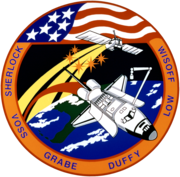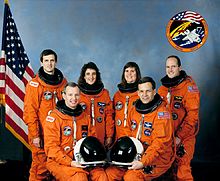STS-57
| STS-57 | |||||
 | |||||
| Uppdrag | 56 | ||||
|---|---|---|---|---|---|
| Rymdfärja | Endeavour (4)[1] | ||||
| NSSDC-ID | 1993-037A[2] | ||||
| Färdens tid | 9 dagar, 23 timmar, 44 minuter, 54 sekunder | ||||
| Uppskjutning | |||||
| Startplats | Startplatta 39B vid Kennedy Space Center i Florida | ||||
| Start | 21 juni 1993, 9:07 a.m. EDT | ||||
| Landning | |||||
| Landningsplats | KSC Runway 33 | ||||
| Landning | 1 juli 1993, 8:52 a.m. EDT | ||||
| Omloppsbana | |||||
| Varv | 154 st[3] | ||||
| Apogeum | 471 km | ||||
| Perigeum | 402 km | ||||
| Banlutning | 28,45° | ||||
| Sträcka | 6,608 miljoner km | ||||
| Rymdpromenad | |||||
| Antal | 1 st | ||||
| Total tid | 5 timmar, 50 minuter | ||||
| Besättning | |||||
| Befälhavare | Ronald J. Grabe (4) | ||||
| Pilot | Brian Duffy (2) | ||||
| Uppdragsspecialister | Nancy J. Currie (1) Peter J. Wisoff (1) Janice E. Voss (1) | ||||
| Nyttolastspecialister | G. David Low (3) | ||||
 | |||||
| Kronologi Rymdfärjeprogrammet | |||||
| |||||
STS-57 var den fjärde flygningen med rymdfärjan Endeavour. Den sköts upp från Pad 39B vid Kennedy Space Center i Florida den 21 juni 1993. Efter nästan tio dagar i omloppsbana runt jorden återinträdde rymdfärjan i jordens atmosfär och landade vid Kennedy Space Center.
Se även
Referenser
- ^ NASA Space Shuttle Launch Archive Arkiverad 28 februari 2009 hämtat från the Wayback Machine., läst 28 juli 2016.
- ^ ”NASA Space Science Data Coordinated Archive” (på engelska). NASA. https://nssdc.gsfc.nasa.gov/nmc/spacecraft/display.action?id=1993-037A. Läst 19 mars 2020.
- ^ Manned Astronautics - Figures & Facts Arkiverad 4 mars 2016 hämtat från the Wayback Machine., läst 28 juli 2016.
Externa länkar
 Wikimedia Commons har media som rör STS-57.
Wikimedia Commons har media som rör STS-57.
| ||||||||
| ||||||||||||||||||||||||||||||||
Media som används på denna webbplats
STS-57 Endeavour, Orbiter Vehicle (OV) 105, crew insignia (logo), the Official insignia of the NASA STS-57 mission, depicts the Space Shuttle Endeavour maneuvering to retrieve the European Retrievable Carrier (EURECA) microgravity experiment satellite. Spacehab -- the first commercial space laboratory -- is depicted in the cargo bay (payload bay (PLB)), and its characteristic shape is represented by the inner red border of the patch. The three gold plumes surrounded the five stars trailing EURECA are suggestive of the United States (U.S.) astronaut logo. The five gold stars together with the shape of the orbiter's mechanical arm form the mission's numerical designation. The six stars on the American flag represent the U.S. astronauts who comprise the crew. With detailed input from the crewmembers, the final artwork was accomplished by artist Tim Hall. The names of the STS-57 flight crewmembers are located along the border of the patch. They are Commander Ronald J. Grabe, Pilot Brian J.
STS-55 Mission Insignia
Författare/Upphovsman: Pascal (Flickr user: pasukaru76), Licens: CC0
Vostok spacecraft replica at the Technik Museum Speyer, Germany.
STS-51 Patch
Pictured in the STS-57 crew portrait (front left to right) are Brian Duffy, pilot; and Ronald J. Grabe, commander. On the back row (left to right) are Peter J. Wisoff, Nancy J. Sherlock, and Janice E. Voss, all mission specialists; and G. David Low, payload commander. Launched aboard the Space Shuttle Endeavour on June 21, 1993 at 9:07:00 am (EDT), the STS-57 mission marked the first flight of the commercially developed SPACEHAB pressurized laboratory.






